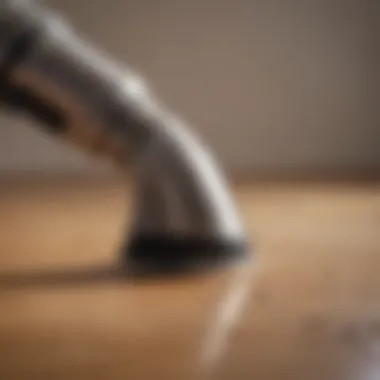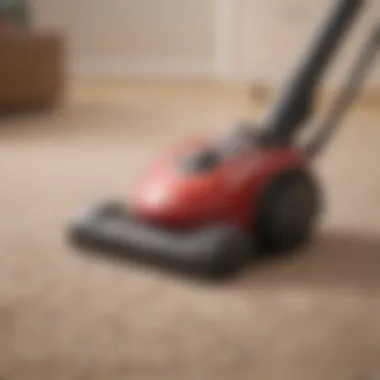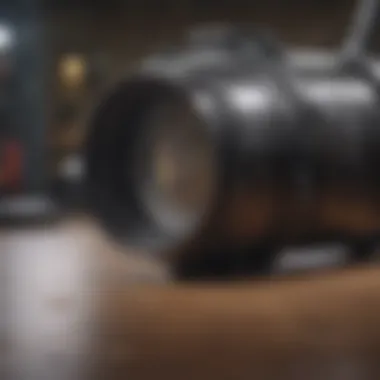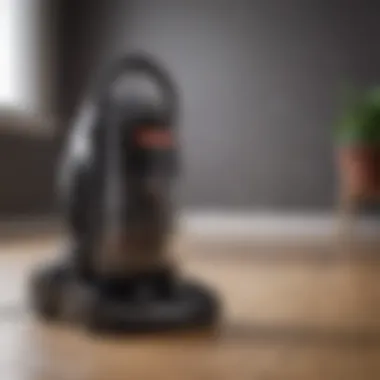Discover the Top Pet Hair Vacuum Cleaners for 2023


Intro
Pet owners often face the ongoing challenge of keeping their homes clean from incessant pet hair. This issue is not just a matter of aesthetics but also relates to health and hygiene. As pets shed their fur, it accumulates on furniture, carpets, and even in the air. This reality underscores the necessity for a high-quality vacuum cleaner designed specifically to tackle pet hair. Given the vast number of options available, understanding which products excel in performance can be overwhelming. This article endeavors to break down the specifics surrounding pet hair vacuum cleaners, enabling readers to make educated decisions based on their unique needs.
Animal Profile
General Overview
For many households, pets play an essential role in family life. Cats, dogs, and other animals often provide companionship and joy. The presence of these animals also brings specific challenges, particularly regarding cleanliness. Pet hair can cling to various surfaces, making it difficult to maintain a tidy living environment. Choosing the correct vacuum cleaner can drastically change the way pet owners manage this ongoing issue.
Habitat and Distribution
Understanding the habits and environments of pets is vital. Dogs, for instance, may shed more during certain seasonal changes, while cats tend to shed consistently throughout the year. Recognizing these patterns can help pet owners anticipate when to vacuum more frequently. Additionally, different types of pets inhabit various environments. By acknowledging these differences, one can choose a vacuum suited for the degree of shedding specific to their pet species.
Care Tips for Pet Owners
Basic Needs and Requirements
To effectively manage pet hair, pet owners should consider a few essential strategies:
- Regular grooming: it minimizes the amount of loose fur that can accumulate in the home.
- Creating a clean area: ensuring pets have a designated space can contain the mess to a more manageable spot.
- Appropriate vacuum selection: it's necessary to understand what features are beneficial for removing pet hair.
Health and Wellness Tips
The presence of pet hair in the home can sometimes be linked to allergies or respiratory issues. Here are some suggestions:
- Choose hypoallergenic vacuums: some models are designed to capture allergens more effectively.
- Frequent filtration changes: maintaining your vacuum is crucial to ensuring it operates at peak efficiency.
- Limit pet access to certain areas: by restricting pets from specific rooms, owners can reduce the spread of hair.
Understanding Pet Hair Issues
Maintaining a clean household can be a significant challenge for pet owners. Understanding pet hair issues is crucial for effectively managing the cleanliness of your space. Pet hair can quickly accumulate, often becoming an unwelcome presence in homes. Recognizing the specifics of these issues will aid in making informed decisions when selecting vacuum cleaners designed to tackle such problems.
The presence of pet hair is not merely an aesthetic concern. It can lead to various practical challenges within a home environment, including allergies and increased cleaning time. Identifying the nature of pet hair and its impact on living spaces will guide the choice of an appropriate vacuum. Consequently, understanding these issues helps prioritize essential features to look for in a vacuum cleaner.
The Challenges of Pet Hair
Pet hair poses several unique challenges. First, the sheer volume can be overwhelming, especially for owners of multiple pets. Fur tends to shed during seasonal changes, and not all breeds have the same shedding patterns. For instance, a Labrador Retriever, known for its heavy shedding, will require more thorough cleaning than a short-haired cat.
Additionally, pet hair can become trapped in upholstery, carpets, and crevices, making it more difficult to remove completely. Traditional vacuum cleaners may not possess the necessary suction power or specialized attachments to effectively eliminate these persistent hairs. This is where understanding the challenges becomes critical. If pet owners are unaware of the specific difficulties associated with pet hair, they may overlook the most suitable vacuum options designed to handle such problems.
Common Household Problems Caused by Pet Hair
Pet hair can lead to several household problems, some of which may not be immediately evident. A few noteworthy issues include:
- Allergic Reactions: Pet hair can carry dander, pollen, and other allergens that may trigger reactions in sensitive individuals. This can create a discomforting living environment, particularly for guests or family members with allergies.
- Dust Mite Attraction: Accumulated pet hair provides a perfect habitat for dust mites, contributing to indoor allergens and necessitating more frequent cleaning of textiles, including bedding and curtains.
- Weakened Air Quality: Dust and allergens carried by pet hair can impact indoor air quality. Poor air circulation due to clogged filters in vacuum systems may exacerbate the problem. Choosing a vacuum with a high-quality filtration system is crucial to combat these effects.
- Increased Maintenance Efforts: Routine cleaning can become a labor-intensive task when pet hair is not adequately managed. This can lead to a buildup of hair in corners and between furniture that accumulates over time, making deep cleaning necessary more often.
By understanding these common challenges related to pet hair, pet owners can more easily identify the benefits and implications inherent in selecting the right vacuum cleaner. This knowledge provides a foundation for making an informed decision that caters specifically to the needs of both pets and their owners.
Types of Pet Hair Vacuum Cleaners


When dealing with pet hair, one of the most crucial factors is the type of vacuum cleaner selected. Each type of vacuum serves different needs and preferences. Understanding these categories helps pet owners make informed choices. This section will cover four primary types: upright, canister, robotic, and handheld vacuum cleaners. Each has distinct advantages and considerations based on home layout, pet type, and personal cleaning habits.
Upright Vacuum Cleaners
Upright vacuum cleaners are a popular choice among pet owners for several reasons. They typically feature strong suction power, which is beneficial for lifting various types of pet hair from carpets and rugs. The design of these vacuums allows for easy maneuverability in larger spaces, making them ideal for homes with multiple rooms and areas covered in pet hair.
Benefits of Upright Vacuum Cleaners:
- Strong Suction: They are effective for deep cleaning carpets, which can trap pet hair within their fibers.
- Floor-to-Ceiling Cleaning: Many models come with attachments to clean above-floor areas, like stairs and upholstery.
- Ease of Use: The self-standing design often allows for straightforward storage.
However, one must also consider the weight. Upright vacuums can be cumbersome to carry, especially up stairs. Additionally, if pets are small or the home has hard flooring, users may find more specialized vacuums better suited for their needs.
Canister Vacuum Cleaners
Canister vacuum cleaners present another effective option for pet owners. These models come with a distinct design that separates the motor and dust container from the cleaning head. This allows for better maneuverability and accessibility in tight spaces.
Benefits of Canister Vacuum Cleaners:
- Flexibility: The separate components make it easier to clean stairs and under furniture.
- Powerful Suction: Like uprights, canisters often feature strong suction, effective on various surfaces including hard floors and carpets.
- Quiet Operation: They tend to be quieter, which is preferable for pets sensitive to noise.
However, canister vacuums can require more effort to manage due to their bulk and the need to transport the canister while cleaning. Their cords can also be a limiting factor if working in larger areas.
Robotic Vacuum Cleaners
Robotic vacuum cleaners have gained popularity, providing a hands-free cleaning experience. These devices autonomously navigate through the home, detecting and collecting pet hair while requiring minimal human intervention. They are particularly useful for maintaining daily cleanliness.
Benefits of Robotic Vacuum Cleaners:
- Convenience: They operate independently, allowing pet owners to tend to other tasks.
- Smart Features: Many models can be programmed or controlled via smartphone apps, offering real-time monitoring and management.
- Regular Maintenance: Ideal for daily upkeep of pet hair with scheduled cleaning.
The primary limitation is their inability to perform deep cleaning. They may struggle with heavy build-up or dense carpet fibers. Furthermore, the capacity of their dust bins is often smaller, requiring frequent emptying.
Handheld Vacuum Cleaners
Handheld vacuum cleaners are the most portable and convenient option for quick clean-ups. They are designed for spot cleaning, making them valuable for addressing immediate messes caused by pets.
Benefits of Handheld Vacuum Cleaners:
- Portability: Light and easy to carry, suitable for quick grabs and cleaning tasks.
- Specialized Attachments: Many models include tools specifically designed for pet owners, like motorized brushes.
- Easy Storage: Their small size allows for convenient storage in small spaces.
Despite these benefits, handheld vacuums are limited in power and capacity compared to larger models. They may not be the best choice for extensive cleaning but excel in managing quick, pet-related clean-ups.
Choosing the right type of vacuum cleaner can make all the difference in managing pet hair challenges efficiently. Each type has its strengths and appropriate contexts for use.
Essential Features to Consider
When searching for the optimal pet hair vacuum cleaner, understanding essential features is crucial. The ideal vacuum should not only collect pet hair effectively but also facilitate maintenance and enhance user experience. Key factors to ponder include suction power, filtration systems, attachments and tools, noise level, and the overall size and weight of the vacuum. Each feature contributes to the efficiency and usability of the vacuum, thus impacting its performance in homes with pets.
Suction Power


Suction power is arguably the most critical characteristic of a vacuum cleaner. For pet owners, strong suction ensures that stubborn pet hair clinging to carpets and upholstery is effectively removed. The capability to adjust suction depending on surface type can also be beneficial. The power of suction can usually be found in specifications. A vacuum with at least 200 AW (Air Watts) is generally recommended for homes with pets. This rating assures that the vacuum can handle heavy shedding and various types of surfaces, like rugs and hardwood floors.
Filtration Systems
Filtration systems play a vital role in improving indoor air quality. Many vacuums come equipped with HEPA filters, which are specifically designed to trap tiny particles including allergens that may come from pet hair and dander. Having a robust filtration system can prevent these particles from being released back into the air, promoting a healthier living environment. When selecting a vacuum, it is essential to confirm how often these filters need replacement. Lower maintenance requirements can be a significant advantage for busy pet owners, ensuring that the vacuum continues to perform well over time.
Attachments and Tools
Having the right attachments can greatly enhance a vacuum's effectiveness. Different tools allow for targeted cleaning in various spaces, such as staircases, corners, and furniture. For example, a pet hair tool can specifically capture hair from upholstery, while a crevice tool is ideal for getting into tight spots. Suction brushes for carpet and specialized attachments for hardwood surfaces can further improve pet hair removal. Assessing which accessories come with the vacuum might aid in making a more informed choice.
Noise Level
Noise level is often overlooked but can significantly affect the cleaning experience. Many pet owners prefer vacuum cleaners that operate quietly, minimizing disruption to both people and pets. A vacuum that generates less than 70 decibels is generally considered quiet and manageable. Furthermore, some models come with a “silent” feature, which reduces noise without sacrificing suction power, providing a more pleasant environment during cleaning.
Size and Weight
The size and weight of a vacuum are practical considerations that can affect usability. A lightweight vacuum can easily be maneuvered around the house, making the task of cleaning less tedious. For those who have multiple floors, a portable option is favorable to avoid physical strain. Conversely, larger, heavier vacuums may offer more powerful suction but could be cumbersome for daily use. Assessing individual needs and home layout can guide pet owners in selecting a vacuum that fits their lifestyle.
Top Brands in Pet Hair Vacuums
Understanding the top brands in pet hair vacuums is essential for anyone looking to address the persistent issue of pet hair in their homes. These brands often represent years of innovation, reliability, and customer satisfaction. Great vacuum cleaners are often more than tools; they are investments that significantly improve the quality of life for pet owners. The right brand often reflects the quality of design and performance. Therefore, selecting a vacuum from a reputable brand can ensure a better cleaning experience.
Brand Overview
Several brands consistently rise to the forefront when it comes to pet hair vacuum cleaners. Some well-known names include Dyson, Shark, Bissell, and iRobot. Each of these brands brings unique features and innovations tailored for pet owners.
- Dyson: Known for its powerful suction and innovative design, Dyson vacuums often have specialized tools for pet hair removal.
- Shark: Shark vacuums are popular for their affordability and effective performance against pet hair. They often include user-friendly features.
- Bissell: This brand focuses specifically on pet hair cleaning technology, offering a range of products designed to tackle stubborn pet hair.
- iRobot: As leader in robotic vacuums, iRobot’s Roomba series is designed to autonomously handle pet hair, easing the burden from users.
These brands have established their reputation through consistent performance and feedback from users, making them reliable choices for pet owners.
Customer Reviews and Ratings
Customer feedback is a powerful tool for understanding the effectiveness of pet hair vacuums. When evaluating vacuum cleaners, it is crucial to consider customer reviews and ratings. They provide insights into real-world experiences. Pet owners share their satisfaction or frustrations regarding suction power, ease of cleaning, and durability.
Many consumers laud Dyson for its superior suction strength and build quality. The reviews often highlight how well it picks up cat and dog hair from various surfaces. Shark users frequently mention the excellent value for money. Meanwhile, Bissell receives commendations for its targeted pet hair attachments that enhance its cleaning efficiency.
Robotic vacuum models such as those from iRobot receive mixed reviews. While many appreciate their convenience, others note limitations in cleaning capability over very thick carpets.
"A well-informed choice backed by user experiences can greatly enhance your cleaning routine and ultimately improve your home's cleanliness."
Expert Reviews and Recommendations
Expert reviews play a crucial role in guiding consumers through the myriad of choices available in pet hair vacuum cleaners. The insights from professionals and experienced users help to illuminate the strengths and weaknesses of various models. Reviews provide details on performance, usability, and efficiency. This is particularly pertinent when facing the challenges of removing pet hair from different surfaces. Thus, understanding expert evaluations becomes essential for pet owners seeking effective solutions.
High-Performance Options
When it comes to high-performance pet hair vacuum cleaners, several models stand out. These vacuums often incorporate advanced technology, ensuring that they tackle pet hair effectively. A vacuum like the Dyson V15 Detect showcases powerful suction and smart sensor technology, adapting its performance based on the type of debris detected. Features such as high-efficiency particulate air (HEPA) filters contribute to cleaner air quality by trapping allergens and pet dander. For those needing superior cleaning power, these high-end options are ideal.
Budget-Friendly Choices


Not everyone has the luxury to invest in a top-tier vacuum. Fortunately, the market offers budget-friendly options that still deliver commendable performance. The Bissell Cleanview Swivel can be a reliable choice for pet owners, with its effective brush roll designed specifically for pet hair. While it may lack some advanced features of premium models, it consistently receives positive feedback for its balance of price and effectiveness. Considerations when selecting economical vacuums include durability, accessory availability, and ease of maintenance to ensure long-term satisfaction without breaking the bank.
Best for Specific Pet Types
Different pets can produce differing amounts and types of hair. Thus, finding the right vacuum based on the specific pet type can enhance cleaning efficiency. For instance, those with long-haired dogs may opt for the Shark Navigator Lift-Away, renowned for its tangle-free brush roll. On the other hand, cat owners might find success with the Hoover PowerDash, thanks to its lightweight design, making it easier to maneuver around furniture. Identifying the pet's needs before purchasing ensures that the right tool is used for effective hair removal.
"Choosing the right vacuum can transform the cleaning experience, making it less daunting and more efficient."
Ultimately, expert reviews serve as valuable resources when selecting the perfect pet hair vacuum cleaner. They encapsulate user experiences which can guide prospective buyers in making informed decisions tailored to their specific circumstances.
Practical Maintenance Tips
Maintaining a pet hair vacuum is critical for ensuring its efficiency and longevity. Regular upkeep not only conserves the performance of the vacuum but also enhances the indoor air quality. A well-maintained vacuum effectively eliminates pet hair, reducing allergens in your home.
Proper maintenance involves key practices that focus on cleanliness and functionality. Here, we will discuss two important aspects of maintenance: regular cleaning of filters and brushes, and effective storage recommendations.
Regular Cleaning of Filters and Brushes
Cleaning filters and brushes regularly is essential to ensure that your vacuum functions optimally. Over time, filters can become clogged with dust, hair, and dander. This blockage can reduce suction power and hinder air flow. Dirty filters can also contribute to poor air quality and allergens.
Here are some key points to consider:
- Frequency: Aim to clean the filters every month. If you have multiple pets, consider doing this bi-weekly.
- Process: Most vacuum filters are washable. Rinse them under warm water and let them dry completely before reinstalling.
- Brush Maintenance: Hair can accumulate around the brush roll. Use scissors to cut away tangled hair, ensuring the brush roll spins freely. This can significantly enhance suction.
- Replacement: Over time, filters and brushes may wear out. Check the manufacturer’s guidelines for replacement schedules.
“A clean vacuum is an effective vacuum. Just like your pet, it requires regular care.”
Storage Recommendations
Proper storage of your vacuum cleaner can prolong its lifespan and maintain its functionality. Keeping your vacuum in optimal conditions limits dust accumulation, avoids damage, and ensures readiness for the next cleaning session.
When storing your vacuum, consider these recommendations:
- Location: Store the vacuum in a dry, cool place to prevent moisture damage.
- Cord Management: If your vacuum has a cord, ensure it’s wrapped properly to avoid tangling. For corded models, using a cord reel can be beneficial.
- Avoid Pressure: Keep the vacuum upright and avoid stacking other items on it. This helps protect the components and the vacuum’s structure.
- Temperature Control: Extreme temperatures can damage electronic components. Try to keep the storage environment at a stable temperature.
In essence, implementing these practical maintenance tips is imperative for any pet owner using a vacuum cleaner. Regular cleaning of filters and brushes, combined with thoughtful storage choices, can significantly enhance the vacuum's performance in battling pet hair and maintaining a clean environment.
Ending
Choosing the right vacuum cleaner for pet hair is of great significance. The presence of pet hair can not only affect a home’s cleanliness but also triggers various allergies and respiratory issues for some individuals. Hence, a vacuum cleaner that effectively tackles this specific challenge is essential for maintaining a healthy living environment.
Final Thoughts on Choosing a Vacuum Cleaner
In evaluating the best vacuum for pet hair, several elements should guide your decision. Understanding the type of vacuum that best suits your home is crucial. An upright vacuum may offer powerful suction but could be cumbersome in tight spaces. Meanwhile, a handheld vacuum might be easier to maneuver but may lack the necessary power for deeper cleaning.
Key considerations include:
- Suction Power: This is vital for lifting embedded pet hair from carpets and upholstery.
- Filtration Systems: High-efficiency filtration can minimize allergens released back into the air.
- Attachments and Tools: Specialized tools for pet hair can enhance cleaning efficiency.
- Noise Level: A quieter machine may be preferable, especially in households with sensitive pets.
- Size and Weight: A lighter vacuum can make cleaning less strenuous, particularly for extended periods.
Taking into account these specific elements can lead to a well-informed choice. Furthermore, learning about established brands and products through customer reviews provides personal insights that can greatly influence the decision-making process.
Ultimately, it comes down to personal needs. Consider the layout of your home, the type of his pet, and your own cleaning habits.
A commitment to regular maintenance ensures the vacuum continues to perform at its best. This involves cleaning out filters, removing hair from brushes, and storing the vacuum in a way that reduces wear.
With careful consideration of these factors, pet owners can choose a vacuum cleaner that not only helps to manage pet hair effectively but also contributes to a cleaner and healthier home environment.















